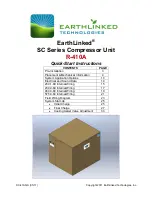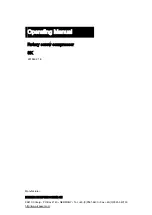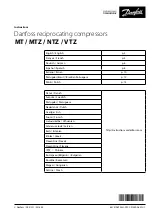
FUEL, LUBRICANTS, and COOLANT
FUEL
Fuel Selection
The following properties are required of the diesel fuel.
Must be free from minute dust particles.
Must have adequate viscosity.
Must have high cetane value.
Must have high cetane value., (45 or greater)
Must have high fluidity at low temperature.
Must have low sulphur content.
Must have little residual carbon.
It is strongly advisable to use ASTM D975 No. 2D (the general
automotive diesel engine purpose fuel oil) or equivalent which fully
meets the above requirements.
Applicable Standard
Recommendation
JIS (Japanese Industrial Standard)
K22O4 -- 2
DIN (DEUTSCHE INDUSTRIE NORMEN)
DIN 51601
SAE (Society of Automotive Engineers) Based
on SAE--J--313C
NO. 2--D
BS (BRITISH STANDARD) Based on
BS/2869--1970
Class A--1 or A--2
ISO 8217
DMA
FUEL REQUIREMENTS
Notice: the fuel injection pump, injector or other parts of the fuel system
and engine can be damaged if you use any fuel or fuel additive other
than those specifically recommended by Ingersoll--Rand.
NOTE:
If any fuel other than the one specified is used, engine operation
will be impaired. Engine failure or malfunction resulting from use of such
improper fuel will not be warranted by Ingersoll--Rand.
To help avoid fuel system or engine damage, please read the following:
Do not use diesel fuel which has been contaminated with engine oil.
Besides causing engine damage, such fuel can also affect emission
control. Before using any diesel fuel, check with the fuel supplier to see
if the fuel has been mixed with engine oil.
Your engine is designed to use either Number 1--D or Number 2--D
diesel fuel. However, for better fuel economy, use Number 2--D diesel
fuel whenever possible. At temperatures less than --7
_
C, (20
_
F),
Number 2--D fuel may pose operating problems (see “Cold Weather
Operation” which follows). At colder temperatures, use Number 1--D
fuel (if available) or use a “winterized” Number 2--D (a blend of Number
1--D and Number 2--D). This blended fuel is usually called Number 2--D
also, but can be used in colder temperatures than Number 2--D fuel
which has not been “winterized.”
Check with the fuel supplier to be sure you get the properly blended
fuel.
NOTICE: Do not use home heating oil or gasoline in your diesel
engine; either may cause engine damage.
Handling of the Fuel
.
Any fuel containing dust particles or water might cause engine
failure .
Therefore, the following must be observed.
Take care to protect the fuel from ingress of dust particles or water
when filling the fuel tank.
If refueling is done from an oil drum directly, ensure that it has been
kept stationary to allow any dust, sediment or water to settle at the
bottom. Do not draw fuel direct from the bottom of the drum to prevent
pickup of any settled foreign material.
Always fully fill the fuel tank. Drain the sedimented particles in the
fuel tank frequently.
Water in Fuel
During refueling, it is possible for water (and other contaminants) to be
pumped into your fuel tank along with the diesel fuel. This can happen
if a fuel provider does not regularly inspect and clean its fuel tanks, or
receives contaminated fuel from its supplier(s). To protect your engine
from contaminated fuel, there is a fuel filter system on the engine which
allows you to drain excess water.
CAUTION:
The water/diesel fuel mixture is flammable, and could be
hot. To avoid personal injury and/or property damage, do not touch the
fuel coming from the drain valve, and do not expose the fuel to open
flames or sparks.
Be sure you do not overfill the fuel tank. Heat (such as from the engine)
can cause the fuel to expand. If the tank is too full, fuel could be forced
out. This could lead to a fire and the risk of personal injury and/or
equipment damage.
Biocides
In warm or humid weather, fungus and/or bacteria may form in diesel
fuel if there is water in the fuel.
NOTICE:
Fungus or bacteria can cause fuel system damage by
plugging the fuel lines, fuel filters or injector. They can also cause fuel
system corrosion.
If fungus or bacteria has caused fuel system problems, you should
have your authorized dealer correct these problems. Then, use a diesel
fuel biocide to sterilize the fuel system (follow the biocide
manufacturer‘s instructions). Biocides are available from your dealer,
service stations, parts stores and other automotive places. See your
authorized dealer for advice on using biocides in your area and for
recommendations on which biocides you should use.
Smoke Suppressants
The use of a smoke suppressant additive is not allowed because of the
greater possibility of stuck rings and valve failure, resulting from
excessive ash deposits.
Summary of Contents for P185WIR
Page 69: ...SECTION 11 PARTS LIST...
Page 70: ......
Page 71: ......
Page 72: ......
Page 73: ......
Page 74: ......
Page 75: ......
Page 76: ......
Page 77: ......
Page 78: ......
Page 79: ......
Page 80: ......
Page 81: ......
Page 82: ......
Page 83: ......
Page 84: ......
Page 85: ......
Page 86: ......
Page 87: ......
Page 88: ......
Page 89: ......
Page 90: ......
Page 91: ......
Page 92: ......
Page 93: ......
Page 94: ......
Page 95: ......
Page 96: ......
Page 97: ......
Page 98: ......
Page 99: ......
Page 100: ......
Page 101: ......
Page 102: ......
Page 103: ......
Page 104: ......
Page 105: ......
Page 106: ......
Page 107: ......
Page 108: ......
Page 109: ......
Page 110: ......
Page 111: ......
Page 112: ......
Page 113: ......
Page 114: ......
Page 115: ......
Page 116: ......
Page 117: ......
Page 118: ......
Page 119: ......
















































